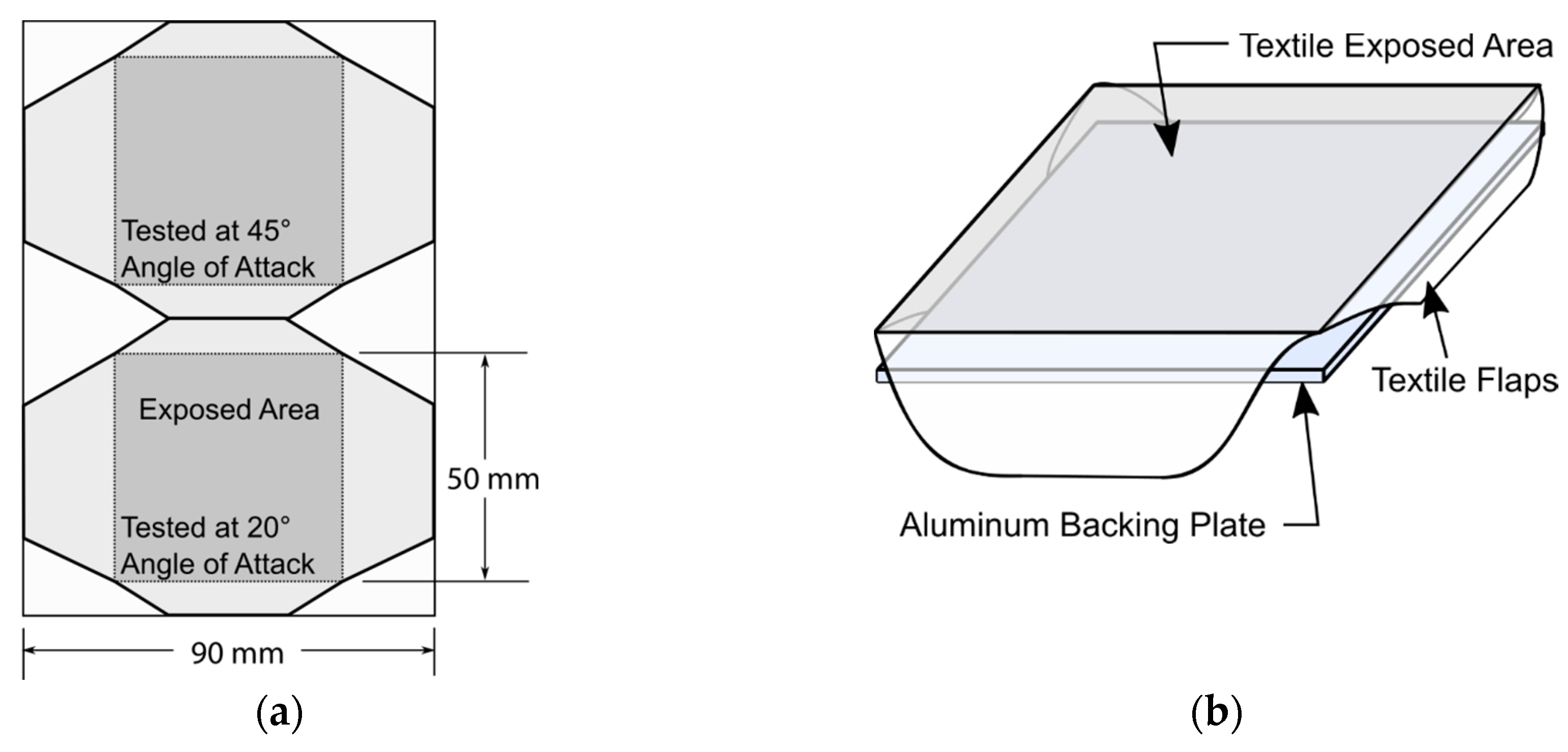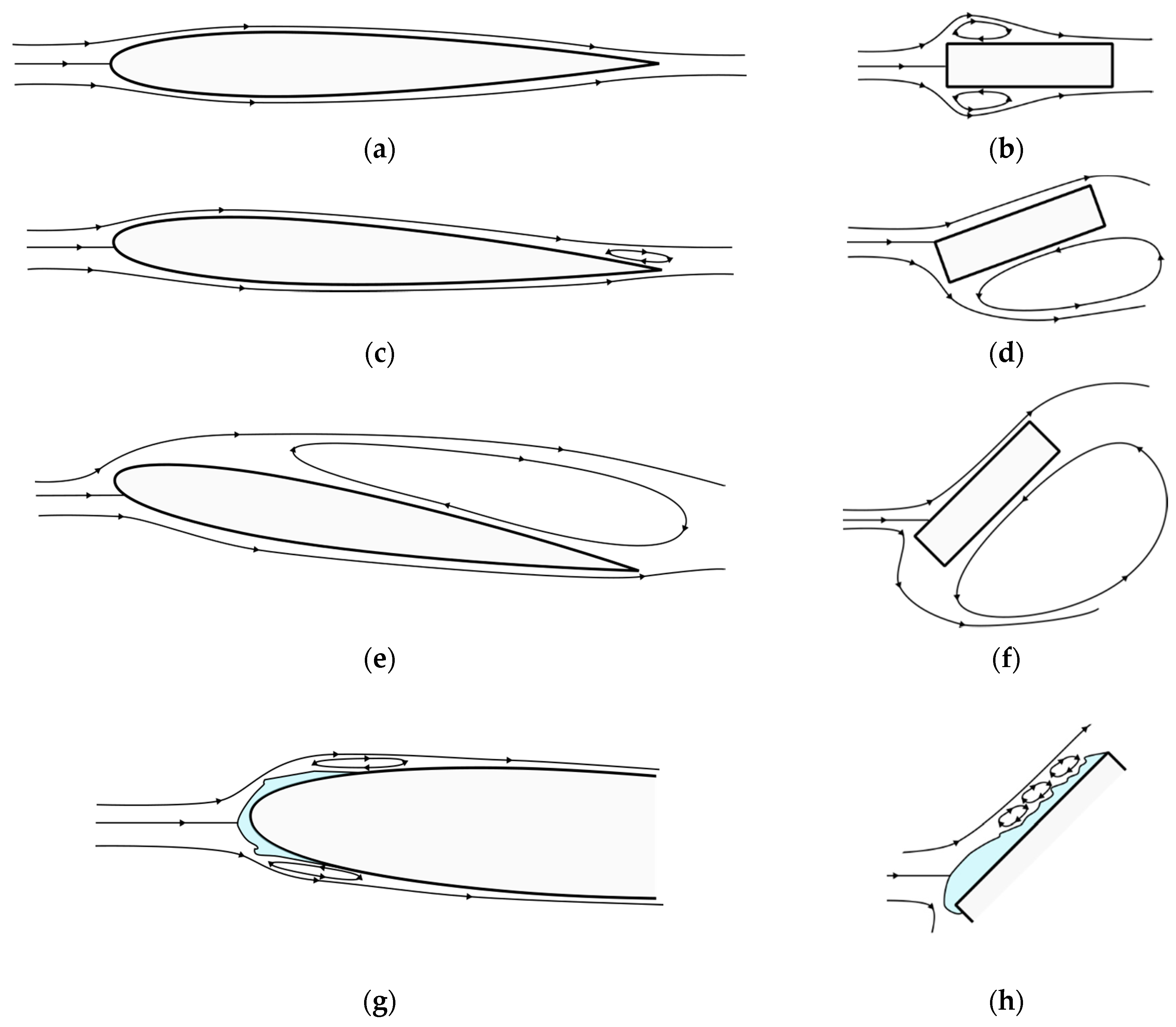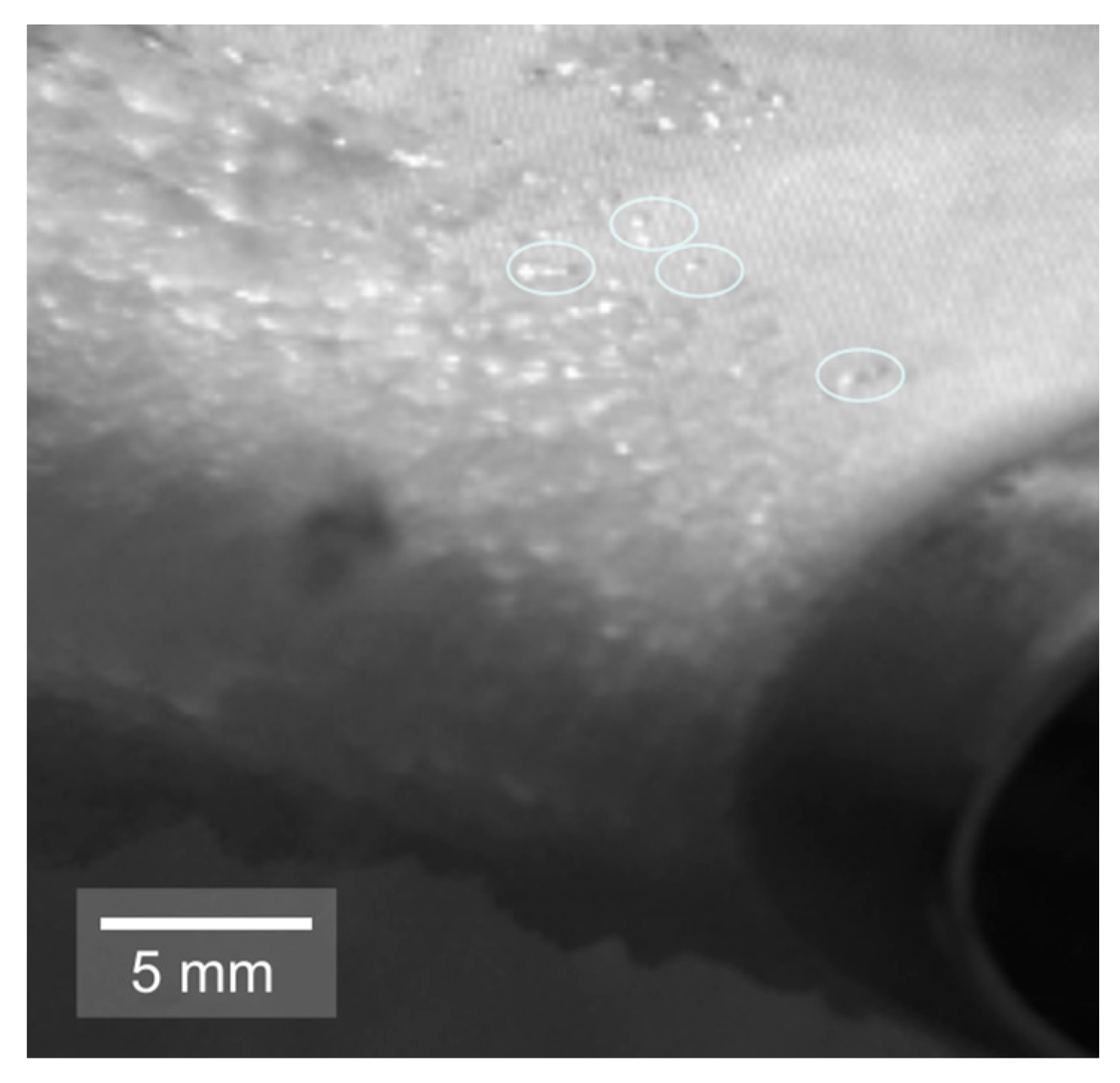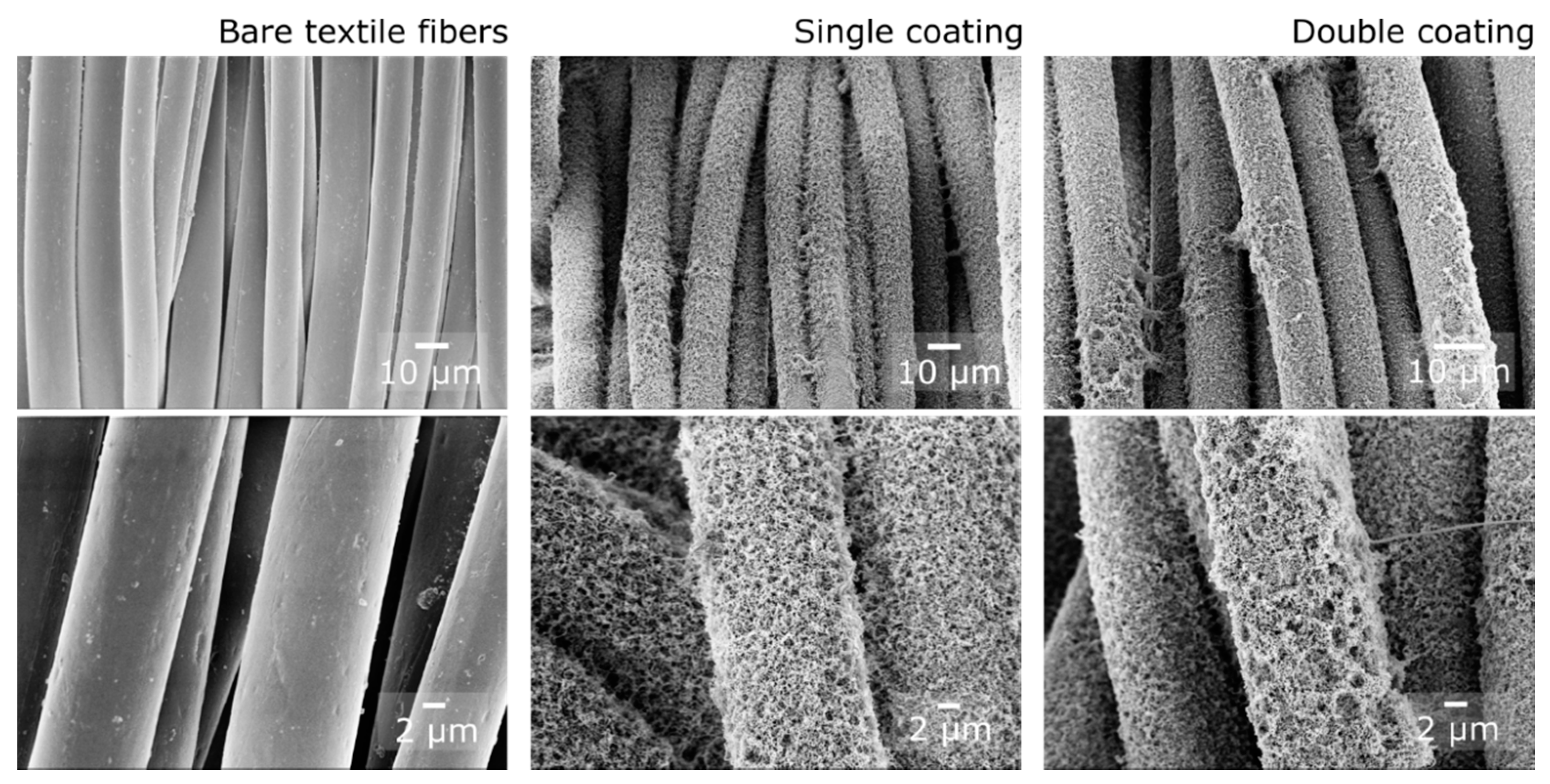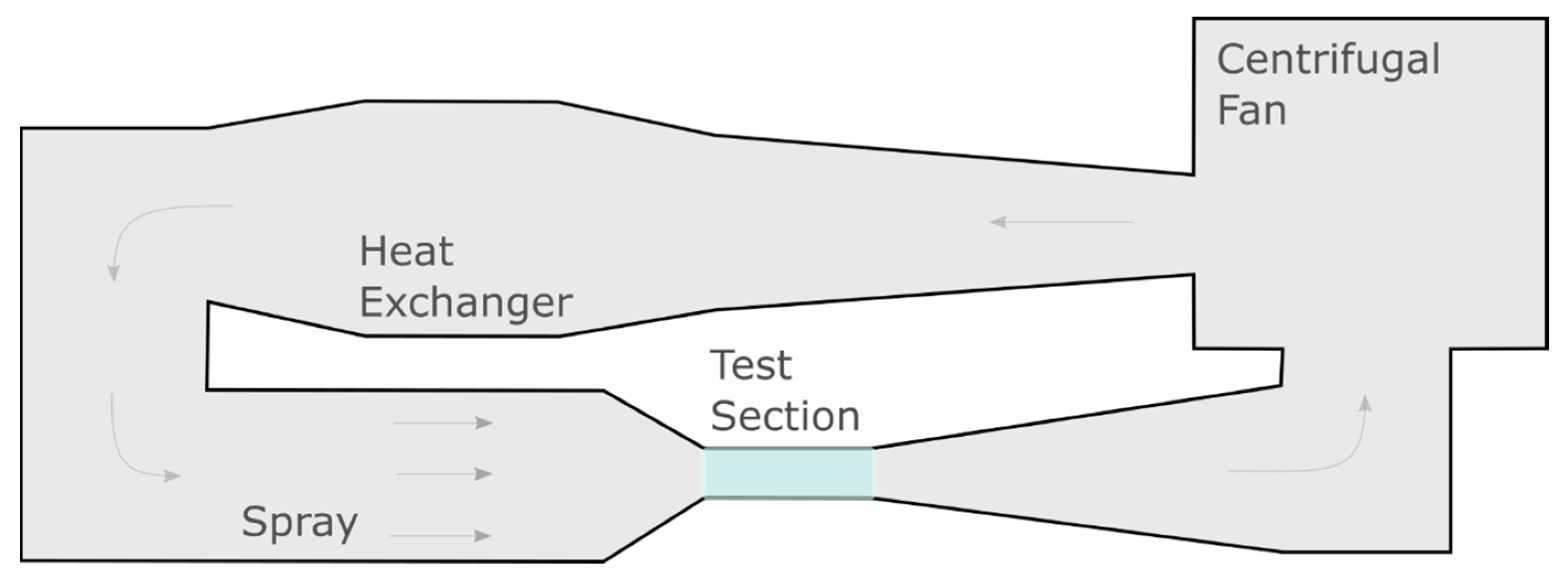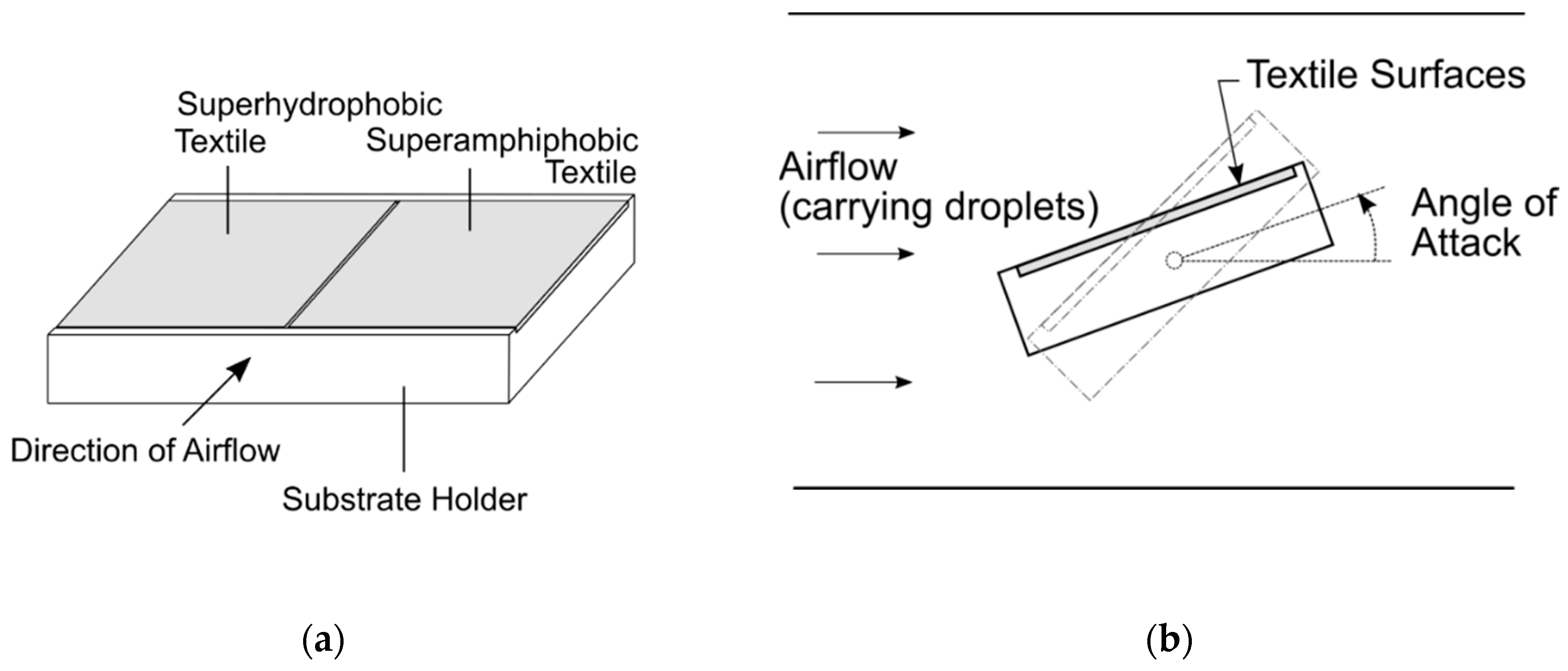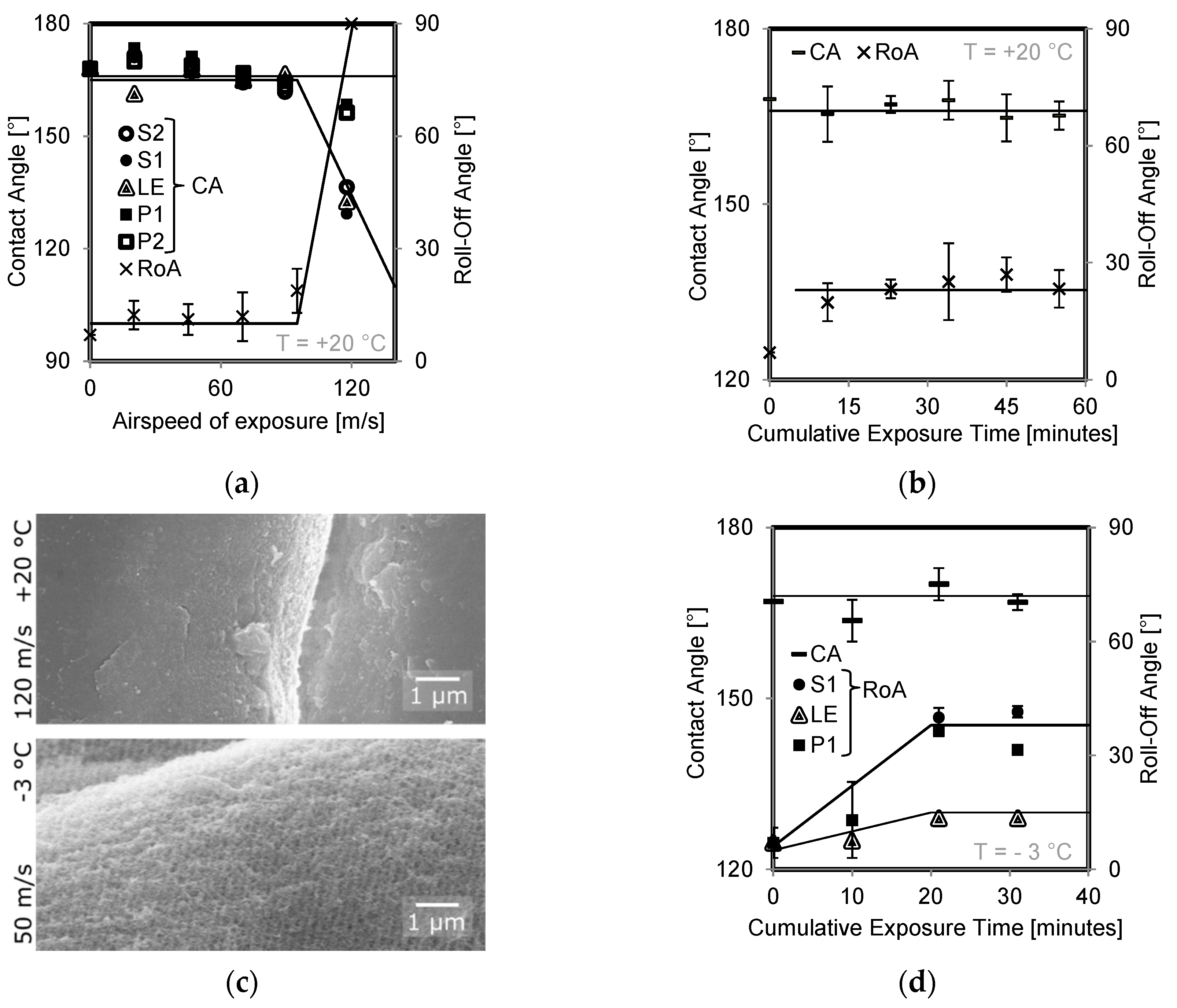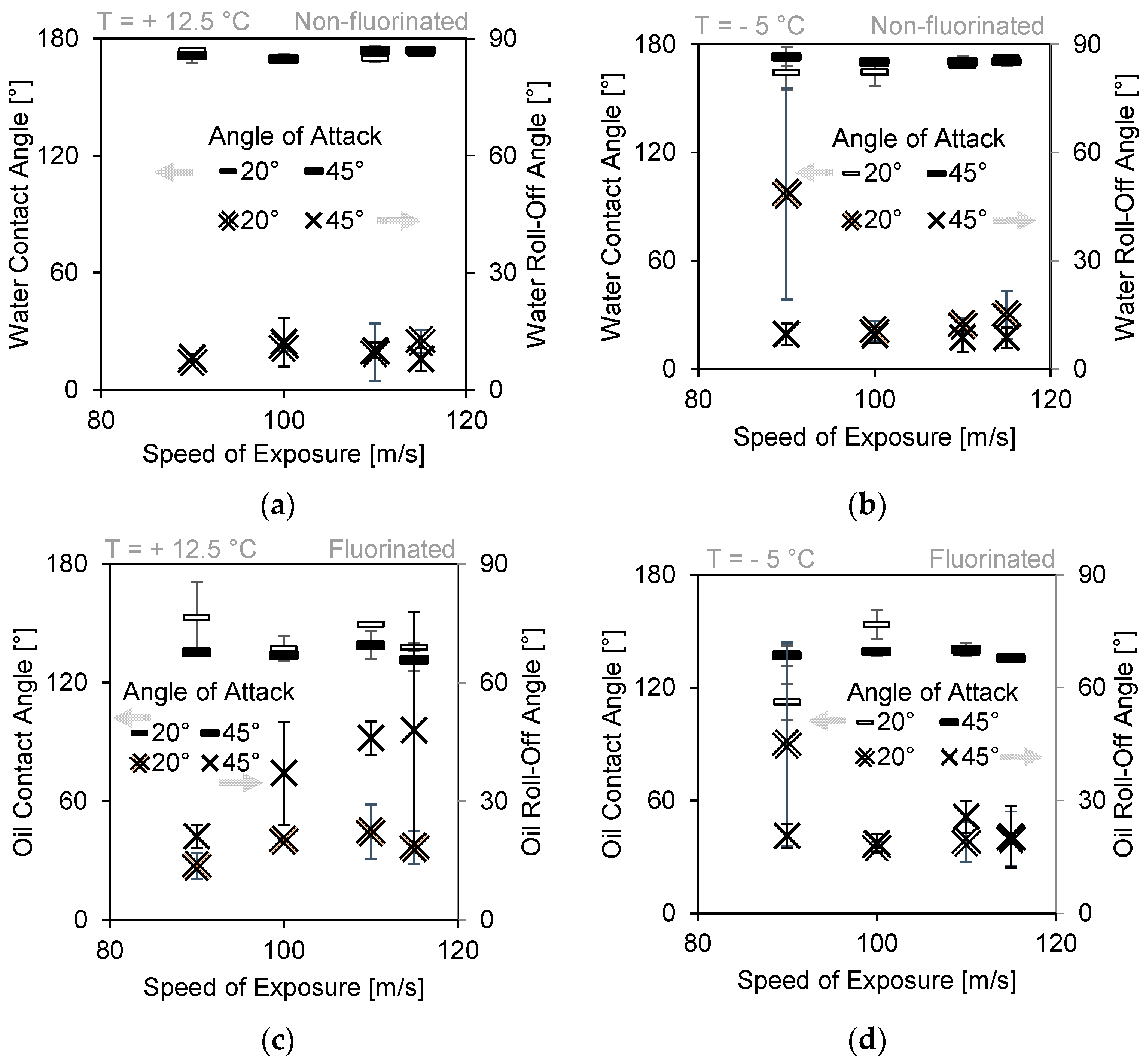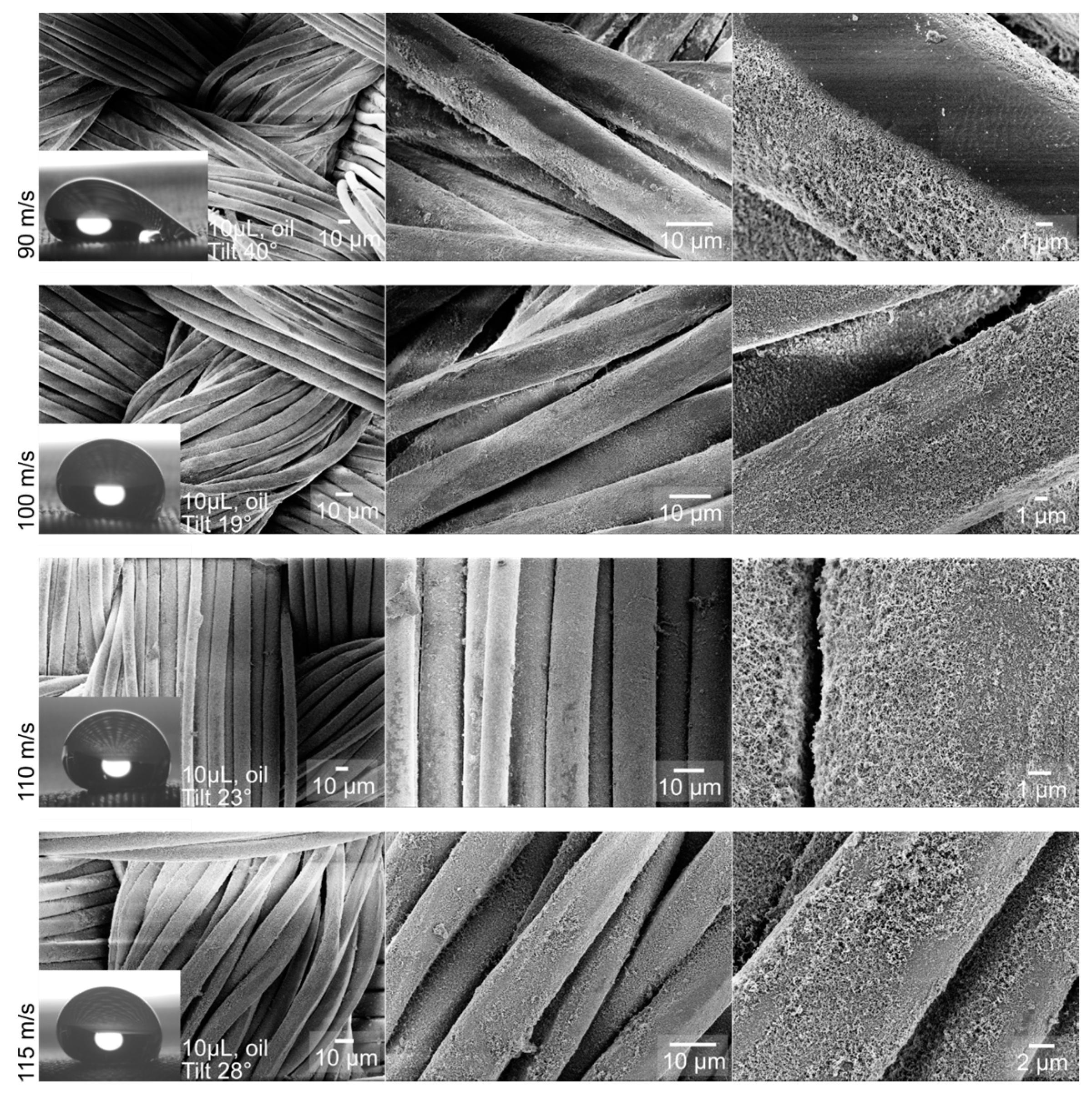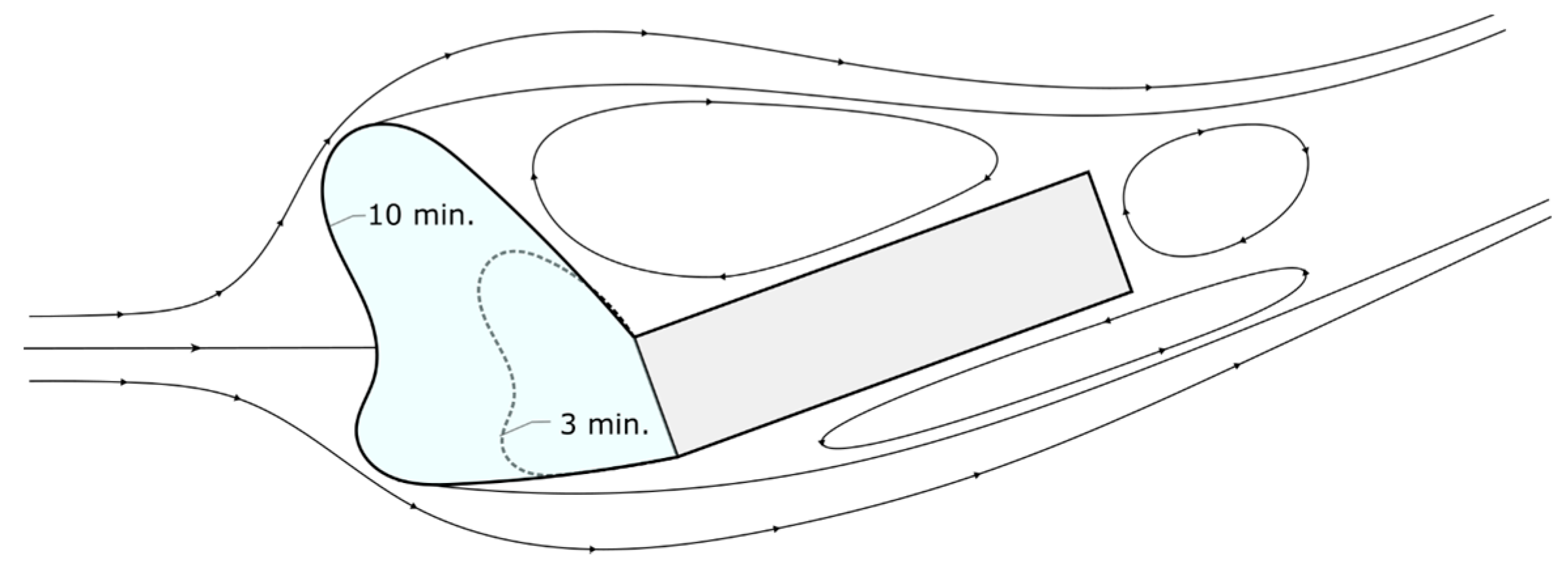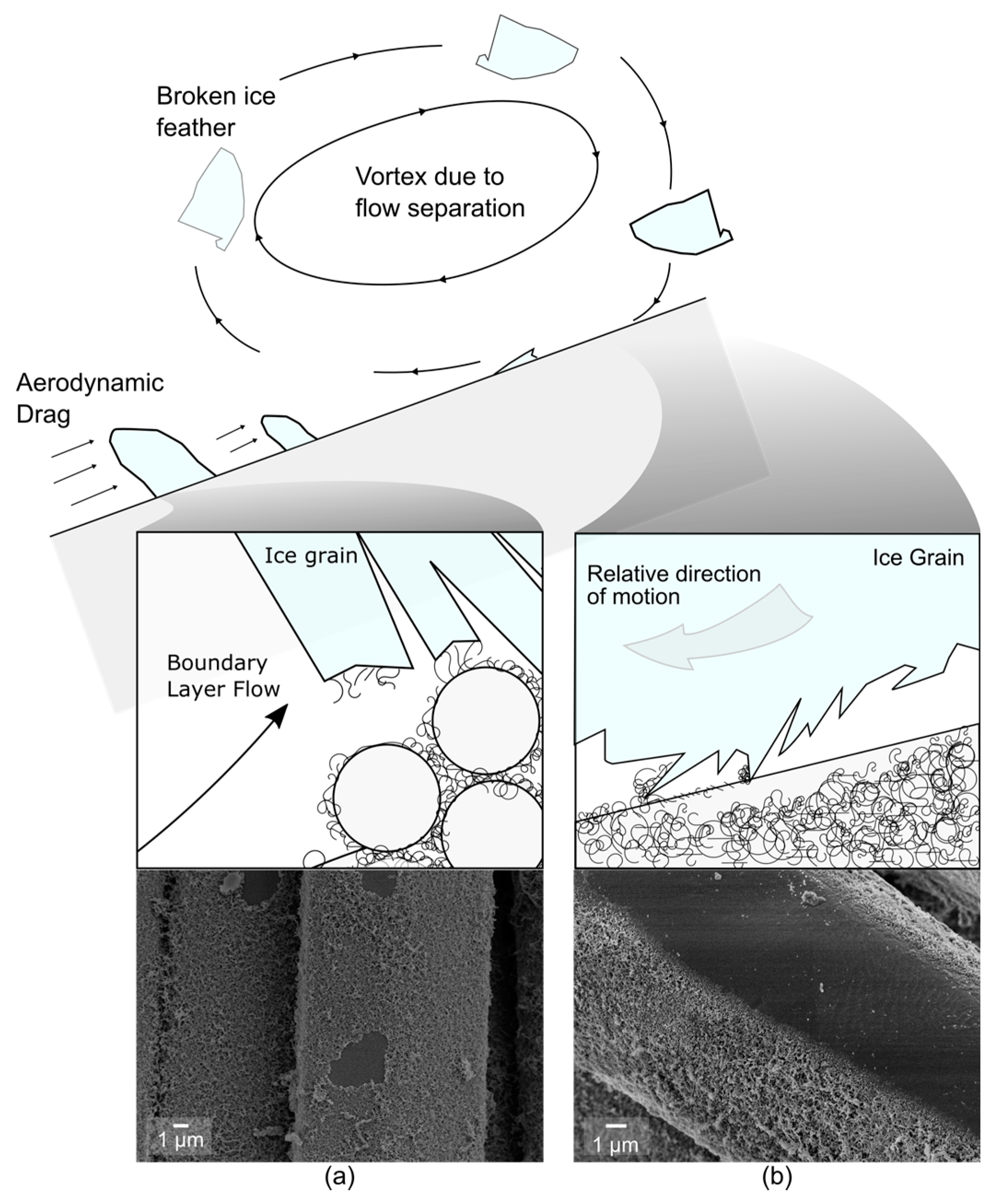1. Introduction
Fabric aircraft skins have been historically important in aviation. A fabric taught over rigid wing spars provides a smooth aerodynamic surface with minimal weight, ideal for small and ultralight aircraft. Due to its low cost and light weight, this concept is still being used to this day on some small aircraft. Although more robust light aircraft are built using carbon fiber composites, many recent home-built or experimental aircraft make use of fabric-covered wings [
1]. These small aircraft typically fly at airspeeds not exceeding 80 m/s or 300 km/h [
2,
3].
At comparatively low speeds and altitudes, contamination of aircraft surfaces is at best an inconvenience and at worst a serious safety concern. A common in-flight external surface contamination is due to insect impact. Another more severe but less frequent source of damage comes from atmospheric icing experienced, e.g., during flight. It is also known as impact icing. This term refers to the impact of supercooled water droplets, which freeze when they collide with the surface of an aircraft. Aircraft icing does not occur during a typical cruise phase of flight, but is common enough after take-off and before landing to be of great concern for pilots and flight planners. If ignored, ice accretion on aerodynamic surfaces can lead to a loss of aircraft control. Fabric covered aircraft typically do not have the energy resources for ice contamination prevention typically used on metal-skin airframes with larger on-board power plants. For example, for the prevention of icing, most metal-skin airframes use some form of heating on critical surfaces to evaporate impacting supercooled droplets. Others use a pneumatic boot, which once inflated, stresses accreted ice to the point of breaking, relieving the surface of ice contamination [
4]. Insect contamination and frost are typically washed off when the aircraft is on-ground. The use of excessive pressure during washing can be problematic for fabric-skin aircraft due to a risk of piercing the skin. An easy-to-clean, superamphiphobic fabric would reduce the pressure needed to remove contamination from a fabric-skin aircraft. It could potentially reduce the risk posed by icing contamination by reducing the adhesion strength to ice, or slowing the accretion of ice entirely.
On the ground, at high altitudes such as in mountainous regions, and at sea [
5], icing similar to that seen in-flight can degrade the performance of signal transmission equipment [
6], and greatly increase safety hazards. Ice accumulated on such equipment is often removed by hand, meaning physically removing the ice using a hand-tool. One solution that has been proposed to ease the removal of ice is to loosely cover the equipment with some fabric before ice begins to form [
7]. The flexible nature of the fabric means it is easy to bend and therefore break ice apart. It logically follows that a fabric with an icephobic or even hydrophobic coating would further ease that process.
A staggering number of hydrophobic technologies and processes has been published in recent years [
8,
9]. Hydrophobicity is dependent on the microstructure, nanostructure, and chemistry of a surface [
10]. On a superhydrophobic or superamphiphobic surface, the droplet partially rests on an air cushion. The reduced contact area helps to support and repel droplets [
11]. To design superhydrophobic or superamphiphobic surfaces, the coatings need to have a low surface free energy. The surface energy is a measure for the amount of energy needed for a fluid (air or liquid) to form an interface with the surface [
12]. A microstructure can decrease the contact area that a liquid has with a surface if air cushions are formed between asperities. The droplet is in the so termed “Cassie state”. A deposited droplet rolls off if the surface is tilted by a few degrees. However, the large spacing between asperities cannot prevent wetting of the surface at high impact velocities. To increase the energy barrier against wetting of the surface by impacting droplets, a nanostructured surface is favorable. The so termed “Cassie-to-Wenzel transition” is prevented or delayed [
13]. Additionally, droplets are less strongly pinned to nanostructures than to microstructures, thus greatly increasing their mobility on a surface [
14]. However, microstructures show superior mechanical stability. Rigid nanostructures can be easily eroded. Typically, nanostructures have poor mechanical durability due to their small cross-sections, which induce higher stress for a given force. Surface chemistry modifications (e.g., hydrophobization or fluorination) conceptually do not fail mechanically, but rather from exposure to corrosive chemicals, extreme temperatures, or certain wavelengths of radiation such as UV [
15,
16].
Coatings composed of silicone nanofilaments (SNFs) have shown superhydrophobicity [
17], and durable superamphiphobicity [
18]. They are chemically inert so they do not decompose in harsh chemical environments, nor do they degrade from exposure to UV [
19]. Conceptually, they show higher toughness (can be deformed more before breaking) than hard nanostructures due to their flexibility. However, on flat glass plates, low mechanical stability of SNF coatings has been reported [
20]. Enhanced durability has been achieved using fabric substrates instead of flat glass [
21]. Fibers and weaves provide a microstructure to the SNF, which protects the sides not facing the shear stress from abrasion, conserving superamphiphobicity. The sponginess of fabrics effectively reduces contact pressure with SNF, reducing the likelihood of them being abraded.
The durability of superamphiphobic fabrics has been evaluated by prolonged chemical exposure, and by exposure to an urban external environment on the outside of a car. The car was driven at speeds up to 120 km/h (33 m/s) and traveled a distance of more than 5000 km. The most severely damaged fabric suffered a water roll-off-angle increase of 20° (from 5° to 25°) and hexadecane roll-off-angle increase of 40° (from 10° to 50°). Despite its degraded performance, SNF remained attached to the polyester fibers after the 257 days of exposure [
18].
The goal of the study was to determine whether superamphiphobic coatings based on SNF are mechanically durable enough for typical flight conditions, including atmospheric icing conditions, experienced by a low-speed aircraft. We investigate whether the bond between SNF coatings and a polyester fabric substrate can withstand aerodynamic shear forces for airspeeds up to 120 m/s (430 km/h). Aerodynamic friction can be considerable, especially at high Reynolds numbers (5.8 × 10
5 during cruise conditions of one exemplary fabric-covered wing aircraft [
3]). On textured surfaces, such as fabrics, boundary layers become turbulent rather early on. The wear due to aerodynamic friction depends also on parameters such as an angle of attack and air temperature. In an icing wind tunnel, we introduce a cloud of micrometric water droplets to simulate flying into a cloud. This impacting spray is analogous to fog and to sea spray but with non-salinized water. Above freezing temperatures, the impact of droplets can resemble liquid-particle erosion. At sub-zero temperatures, these water droplets are supercooled and freeze on impact, simulating in-flight impact icing. The median volumetric diameter of the particles was 20 µm, smaller than the mean spacing between fiber bundles. That means that droplets can penetrate into the fabric, affecting non-superficial polyester fibers. We demonstrate that the coated fabrics can withstand impact of supercooled water droplets up to 120 m/s for several minutes.
2. Materials and Methods
Commercial fabrics were coated using a well-documented technique [
15]. The coated fabrics were exposed to controlled environmental conditions in a small-scale icing wind tunnel and thereafter characterized by wettability to water or oil, and by scanning electron microscopy. For readers unfamiliar with the terminology used in aerodynamics, the terms found in this study have been concisely defined in
Appendix B.
2.1. Substrate Preparation
Plain weave polyester fabrics (poly(ethylene terephthalate) or PET), purchased from Karstadt (Essen, Germany), were immersed in a solution of trichloromethylsilane (Sigma-Aldrich Chemie GmbH, Taufkirchen, Germany)(0.4 vol.%) in toluene (Fisher Scientific GmbH, Schwerte, Germany) containing water at 150 ppm, for 3 h (1-step). To increase the thickness of the coating, the solution was exchanged and replaced by a fresh solution (2-step). We refer to them as a 1-step and 2-step procedure. Upon removal from the solution, they were rinsed with n-hexane (Fisher Chemical) and dried with nitrogen. This process was used to grow a SNF network on the fabrics, making them superhydrophobic.
Superamphiphobicity was achieved by binding fluorine groups to the surface of the SNF. Coated fabrics were activated in an oxygen plasma chamber (120 W, Femto, Diener Electronic GmbH + Co. KG, Ebhausen, Germany) for 2 min. They were then immersed in a solution of 1H,1H,2H,2H-perfluorodecyltrichlorosilane (PFDTS, 0.05 vol.%) in n-hexane for 20 min. Upon removal, they were rinsed in n-hexane and dried with nitrogen gas. The procedure has been detailed in [
15,
18].
Fluorination is necessary to make the fabric superamphiphobic, however, superhydrophobicity is sufficient for many applications. Fluorination improves the water repellency of the coating by lowering its surface energy; contact angles increase and roll-off angles decrease. For comparison, we coated the SNF with a nanometer thin PDMS film. A PDMS film reduces the surface energy of the coating, while being more environmentally friendly than fluorine. Moreover, PDMS provides the filaments with “slippery” properties, potentially reducing the adhesion of ice.
To coat silicone nanofilaments with PDMS brushes, the fabrics coated with SNF were activated in an oxygen plasma (2 min, 120 W) and thereafter dipped into a solution for 15 s. The solution consisted of 0.43 mL (8.0 mmol, 1 wt.%) of sulfuric acid (H2SO4, 95%–97%) and 8.9 mL of dimethoxydimethylsilane (65 mmol, 10 wt.%) in 100 mL of 2-propanol. Prior to dipping the fabrics, the reaction mixture was stirred for 30 s and allowed to be stagnant for 30 min at room temperature. After dipping, excess solution was removed with a paper towel. The sample was then placed in a desiccator for 20 min with the plasma-activated side facing upward. The humidity inside the desiccator was regulated between 50% and 70% by releasing nitrogen gas, that has passed through a wash bottle containing Milli-Q water, into the desiccator. After 20 min, the sample was removed and washed with toluene, 2-propanol, and water respectively, then dried under a nitrogen stream. After coating with PDMS, the surface was superhydrophobic.
The fabrics were imaged before and after coating by scanning electron microscopy (SEM),
Figure 1. SEM images were taken using a Zeiss LEO 1530 Gemini SEM (Carl Zeiss AG, Oberkochen, Germany) at gun voltages of 3 kV with an in-lens detector. To avoid charging, samples were sputtered with 7 nm Pt using a BalTec MED 020 modular high vacuum coating system before measurement, with an argon pressure of 2 × 10
−5 bar and a current of 30 mA (Bal-Tec AG, Balzers, Liechtenstein). The bare fibers in the fabric were smooth with frequent but random minor defects. The fabrics that were coated once (1-step) show a slightly more uniform coverage of SNF on the fibers than those coated twice. The average thickness of the coating increased from approximately 1.5 µm after the first step to approximately 2.5 µm after the second step. The thickness of the nanofilaments varied between 50 and 100 nm and the spacing between filaments ranged from 100 nm to 2 µm (2 step). No change of the morphology could be detected after fluorination or coating with PDMS.
2.2. Icing Wind Tunnel Testing
The icing and contamination research facility (iCORE) is a closed-loop wind tunnel equipped with a test section 100 mm wide and 150 mm high. The wind tunnel is fitted with an additional cooling section and spray section,
Figure 2. The coolant flowing through the heat exchanger in the cooling section is pressurized by three compressors, one of which with variable power, allowing the air in the wind tunnel to reach temperatures as low as −40 °C. The spray section, upstream of the test section, includes three horizontally aligned, internal mix, air atomizing nozzles capable of producing water droplet clouds with a median volumetric droplet diameter (MVD) of 2
= 20 µm, and a resulting liquid water content (LWC) of up to 2.0 g/m
3 in the test section. The icing wind tunnel is driven by a fan, which can force air into the tests section up to a speed of
= 140 m/s. Assuming laminar flow, a water droplet in the test section would have a Weber number,
= 2800, and a dynamic wetting pressure of
Here,
is the density of water,
the impact velocity,
the interfacial tension, and
R the radius of the droplet. Further details on the icing wind tunnel and its calibration have been presented by Hauk et al. [
22].
The superamphiphobic fabrics were mounted in the icing wind tunnel test section in two different configurations: on the leading edge of an airfoil (
Figure 3), and on the top of an inclined flat plate (
Figure 4). The airfoil profile provided a more realistic aerodynamic shape, giving insight into the specific wear conditions that the fabrics would see in-flight. The NACA 0012 shape was chosen because it is a relatively simple shape without camber, making it easy to manufacture and analyze [
23,
24,
25]. The flat plate configuration was useful for studying relatively uniform wear conditions and controlling the angle of attack.
A NACA 0012 shape was used for exploring three pressure zones, namely, stagnation, suction, and pressure. The stagnation line, referred to as the leading edge (LE) in
Figure 3, gets its name because that is where air hits the object and coms to a halt; it is a theoretical singularity point but in practice is the region of highest pressure. If the airfoil were tiled upward or if the centerline were curved (non-zero camber), then the stagnation line would be slightly below the centerline (also referred to as chord). The consequence would be that air passing over the top side would need to go faster than air passing under the bottom side because it would have to cover a slightly longer distance on the top in the same amount of time. As air velocity increases, static pressure decreases (in an adiabatic system), meaning that the air on the top side has a lower static pressure than on the bottom side, giving it the name, suction side. The airfoil configuration was tested in a 0°-angle of attack, so the absence of any camber meant the pressure and suction sides were not effective as such; they were just for designation and labeling. Fabrics were placed mid-span of the airfoil and covered up to the 45-mm chord-wise position. Three identical superamphiphobic fabrics were tested in this configuration, illustrated in
Figure 3.
Polyester fabrics were coated as square sheets with a side length of 100 mm. To fit the flat plate substrate holder, the corners of the sheets were cut as shown in
Figure A1a. An aluminum plate (50 mm × 50 mm × 2 mm) was used as the core support for the fabric. The effective area of the fabric was placed on one face of the aluminum plates and the side flaps were folded over to the back (
Figure A1b), where they were held in place using adhesive tape. One superamphiphobic and one superhydrophobic fabric were tested simultaneously side-by-side in the icing wind tunnel as illustrated in
Figure 4.
Figure 4b is a side-view diagram of the flat-plate configuration showing direction of airflow and the angle of attack (AoA). A total of 14 superhydrophobic and 14 superamphiphobic fabrics were tested in this configuration, each one exposed to a single combination of airspeed, temperature, and angle of attack.
The environmental conditions that the fabrics were exposed to are listed in
Table 1. For the two used configurations, above freezing and below freezing air temperatures were tested. Airspeeds ranged from 20 to 120 m/s for the airfoil, and from 90 to 115 m/s for the flat plate. The airfoil was tested at a single 0°-angle of attack. The airfoil shape was such that the fabric’s effective incident angle with air ranged from 0° at the maximum airfoil thickness (S2 and P2 in
Figure 3), to 90° at the stagnation line (LE in
Figure 3). The flat plate was placed in either one of two angles of attack: 20° or 45°. The sample holder was in-fact a rectangular prism rather than a thin plate (leading edge flat face was 15 mm thick) so a minimum angle of attack of 20° was needed to prevent flow separation on the top surface [
26] and to ensure interaction of the fabric with impacting water droplets. A 45°-angle of attack provided more direct exposure to the droplets and raised the stagnation line above the bottom edge of the fabric. The total duration of exposure was kept constant at 10 consecutive minutes for the flat plate configuration to allow for a higher number of test conditions, whereas on the airfoil configuration, cumulative exposure time ranged until 50 min. Instead of using fixed liquid water content (conventional metric for the concentration of water droplets in a cloud), a fixed water volume flow rate of 10 cm
3/min was introduced into the air through the air atomizing nozzles. The difference in droplet impact rate between a constant liquid water content and constant feed rate is subtle for the range of conditions tested (liquid water content was between 0.25 and 0.36 g/m
3). The leading edge portion of the airfoil was subjected to an impact rate of 4 and 10 droplet impacts/s for airspeeds of 50 and 120 m/s respectively. For an exposure of 10 min that accumulated to 2500 and 6200 impacts, respectively. For the total of 50 min of exposure at progressively increasing airspeeds, the number of droplet impacts over the leading edge of the airfoil is estimated at 18,000.
2.3. Characterization
A Krüss DSA 30 (Hamburg, Germany) contact angle measuring device with an automatic tilting axis was used for the measurements of the equilibrium contact angle and roll-off-angle. Milli-Q water droplets were 6 µL in volume and oil droplets (sunflower oil, THOMY, Frankfurt, Germany) were 10 µL. The stage was tilted at a rate of 1.5°/s and recorded at 1 frame per second, resulting in a minimum measurement uncertainty of 1.5°. The Young Laplace fitting method in the Krüss ADVANCE software was used to calculate the water contact angle, and the ellipse fitting was used for that of oil. The accuracy of the measurement was decreased by the optical nature of the fabrics, which made it difficult to measure the three-phase contact line for angles above 160°. Visible bumps and a lack of reflectivity made it difficult to accurately define a baseline. On superhydrophobic and superamphiphobic surfaces the advancing contact angle is expected to be close to 180° [
27]. The water contact angle of pristinely coated fabrics has been measured previously using confocal microscopy [
15].
Following icing wind tunnel and wetting properties tests, a circular punch was used to cut 5 mm-diameter circular samples near the center of each fabric for SEM measurements.
4. Summary and Conclusions
The superamphiphobic fabrics maintained their favorable wetting properties after exposure to a range of aerodynamic multiphase flow conditions, including those conducive to atmospheric icing of aircraft. When they were slightly damaged, they retained a high contact angle and much of the changed, but their chemistry and microstructure remained intact. Exposure to an airflow up to 115 m/s, to clouds of water droplets, and to icing conditions in a laboratory icing wind tunnel appeared to damage the fabrics similarly to an extended exposure on a car side-view mirror, but not significantly more [
18]. When exposed to external environments like on a car, the conditions are much less controlled than in a laboratory test: mechanical degradation can occur from different types of impacting particles (rocks, sand, hail, and insects) and chemical degradation of of organic fluorine groups can occur after prolonged exposure to UV radiation. The results of this study show that exposure to small water droplets, even supercooled ones, at speeds up to 430 km/h, only slightly degraded the performance of a superamphiphobic fabric on a flat plate.
Complete failure occurred at Reynolds numbers >1.4 × 106 (speed of 120 m/s on a NACA 0012 airfoil) and mostly on the suction side of the airfoil. Thus, the fabrics may not be durable enough for forward facing surfaces of single-engine propeller aircraft that operate at that or at higher speeds. For low speed aircraft such as for urban air mobility, experimental aircraft, agricultural aircraft, drones, or gliders, aerodynamic shear on its own does not appear to be aggressive enough to remove the SNF coating. For cases where icing occurs over long periods of time and at relatively low speeds, such as for telecommunication antennae or oil rigs at sea, the first layer of ice build-up would protect the fabric from damage, meaning the icing conditions there would not cause significant damage to the superamphiphobic coating if the ice is not removed by hand, but allowed to detach when the ambient conditions become more favorable.
